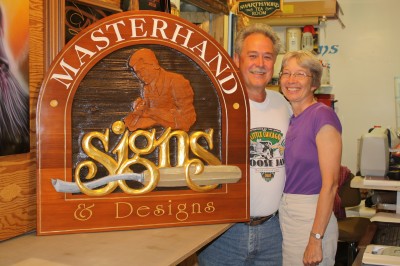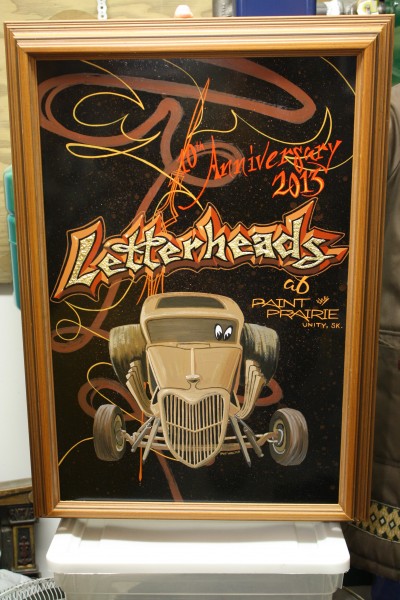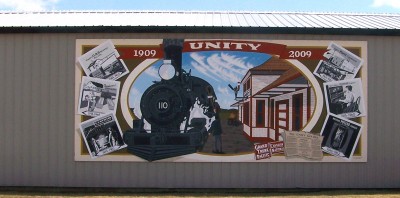Sign Shop Profile: Masterhand Signs & Designs
by all | 21 November 2013 8:30 am

Photos courtesy Masterhand Signs & Designs
By Peter Saunders
In business since 1988, Masterhand Signs & Design is celebrating its 25th anniversary this year. Pat and Ruth Welter, a husband-and-wife team living just outside Unity, Sask., have found a niche by specializing in handcrafted signs, handpainted murals and other works with a personal touch.
The art of advertising
Before he became a signmaker, Pat worked in the broadcasting industry, handling sales and marketing for radio stations in Saskatchewan and Alberta. While he says he didn’t enjoy the politics of the business, the experience made him more fully appreciate the importance of advertising.
“A lot of people, when they start a business, don’t yet realize what advertising can do for them,” he says. “They would jump in before they had the tools to market their good ideas. In retail, for example, they would pour their money into buying a building and filling the store with products, but they still needed marketing to get customers through their door. So I would come along, research their business, show them a marketing plan and explain what they were missing out on, how their potential customers’ dollars were going elsewhere.”
Through this process of considering advertising in different forms, Pat began to notice a relative lack of signage in the marketing mix.
“Many of my retail clients would advertise via radio, TV and newspapers, but never follow up with signs in their stores,” he explains. “That’s how the sign industry caught my attention.”
Pat’s hobbies from a young age included sketching, carving and drawing, so he was already well-positioned to transition into a new career as a signmaker when he decided to leave broadcasting. He also read lots of books about sign layout and lettering.
“Signs caught my heart,” he says. “I couldn’t have found a better niche to stumble into.”
Ruth was working at a bank at the time, which helped bring in enough outside income to offset what Pat left behind in his old career.

This turtle-and-ship float was designed by Masterhand for the Knights of Columbus to drive through a parade at the 2006 Calgary Stampede.
“As I got busier, though, I needed her to help me with the paperwork,” he explains.
“He had a friend’s assistance at first,” says Ruth. “Then I quit the bank to do some of the basic work for him. It eventually became a full-time job. I answer the phone when he’s in the middle of something. I work on murals, with Pat telling me what to paint. I mix the paints and clean the brushes. I can cut and weed vinyl for decals. Because of what I do, he can handle more production.”
“Ruth can also look at my work more like a customer would, rather than as a designer, and provide valuable feedback,” says Pat.
The personal touch
As in Pat’s radio days, Masterhand clients are mainly retailers, although some custom signs are built for homes and farms.
“The town really supports us,” says Pat. “Given the population here is just over 2,500, we’ve had to become pretty well-rounded. I do vinyl cutting, painting, gilding, airbrushing, carving, gluechipping and pinstriping. We don’t have a digital printer, but there’s a shop in Swift Current, Sask., called Signs ’n Such that can do that work for us.”
Indeed, despite trends elsewhere in the sign industry, Masterhand has benefited from what Pat sees as a resurgence of interest in unique, handmade pieces.
“Technology is great, but the handmade stuff is by far the most satisfying,” he says. “Other signmakers wonder how we get so much gold leaf work out here in the Prairies, for example, but when you compare handcrafted signage to the lifetime of a digital print, you can see why many of our customers choose the former. And where many customers today seem to expect a sign in an hour, ours understand it will take a week or two.”
The benefits of handcrafted signage are all part of Pat’s pitch, particularly to new clients.
“We’re not pushy or hard-sell, but at the beginning, I’ll provide several designs, each a grade higher than the last, so they see the difference in quality,” he explains. “About 95 per cent of them go up from what they originally told us their budget was. We see a lot of upselling from a $1,000 sign to a $3,000 sign. No one blinks an eye or calls us crazy, because they realize there is skill and work behind it. It’s all about showing what you can do for your customer.”

Pat Welter starts with pencil sketches before painting his panels with lettering enamel and adding gold leaf.

Masterhand’s humble facilities comprise a 7.3 x 7.9-m (24 x 26-ft) office and a 7.3 x 8.5-m (24 x 28-ft) garage full of traditional woodworking tools.
“The space is not very big,” says Pat. “Sign folks visit and wonder how I work here, but it goes in waves. Sometimes I’m solidly doing lettering work in the shop and sometimes I’m out applying vinyl decals to a fleet of trailers.”
Notably, the Welters do not use a computer numerical control (CNC) router for any of their work.
“I see lots of CNC out there, but it’s fairly costly to get into for one-offs,” says Pat. “The mainstay of our business is still customers coming here for a unique piece, where the overhead costs are lower if I just do the work by hand. Also, when you put them side by each, CNC-finished sign letters don’t look the same as their hand-carved counterparts.”
The Welters even do a lot of their own installation work.
“For billboards, we hire a fellow to drill holes and then we bolt the posts and the structure all together,” says Ruth. “We put chains on the structure and lift it into place. I don’t like heights, but I’ve gotten up on the scaffolding from time to time!”
 [1]
[1]Pat Welter says other signmakers wonder how Masterhand gets to do so much gold leaf work in the Prairies, but explains his customers generally prefer handcrafted signage over digitally printed graphics.
Besides his self-taught skills gleaned from books, Pat has actively sought out and learned from other signmakers. In 1998, he found out about the Letterheads, a worldwide community of sign artists specializing in pinstriping, airbrushing and other ‘non-digital’ techniques. He started to attend Letterhead Meets—beginning with one in Banff, Alta., led by well-known signmaking instructor Larry Whan—to further his education.
“It was a revelation, watching guys do all of the different stuff I wanted to learn,” he says. “A Letterhead Meet is like going to university. They’re a tightly knit family and you get to learn from people who have gone through it all. It’s enjoyable and fun. When I saw artists gilding a vintage fire truck I got right in, tried it and haven’t looked back since!”
At a sign-industry show in Vancouver one year, Pat was part of a team of artists—including Dan Sawatzky, René Giroux, Cal Trauter and John Lennig—who worked collectively on a customized sign project, dubbed the ‘Beaver Dam.’ As they produced the work at a booth at the back of the show, lineups of attendees and exhibitors gathered to watch.
“Even as the show was closing for the day, there was a long line of people to talk to us,” says Pat. “It’s the same when Ruth and I are painting murals. People come around and stand there, mesmerized by what we’re doing and how we absolutely enjoy doing it. They have the same passion for artwork in their hearts, they just have to reach out and grab it.”
Passing the torch
In 2009, for Unity’s centennial, the town commissioned a large mural depicting its history and culture. The Welters worked with the senior art class at the high school.
“We’ve lived here all our lives, but learned so much of the history of Unity when designing the mural, more students came around to hear about it,” Ruth says. “Pat talked to every class in town and it was amazing the questions even the youngest kids would ask. Finally, at the centennial celebration, Pat gave a presentation about the various elements in the mural, such as the creamery, the railway and the potash mine.”
Installed on the wall of a lumber building downtown, the mural also represented the culmination of Masterhand’s work with the community.
“Since our first mural on a liquor store wall in 2000, we’ve had all sorts of kids help us over the years,” says Ruth. “We’ve painted seven murals in town and none has ever been defaced. I sometimes wonder if that’s because we’ve involved the kids in the process.”
 [2]
[2]In 2009, for Unity’s centennial, the town commissioned a large mural depicting its history and culture. The Welters were assisted by the local high school’s senior art class.
Pat has taught some airbrushing classes to local students. He and Ruth have also worked with the school to launch a series of gallery-style shows specifically to highlight art students’ work. The first was in 1999 and there has been a show each year since.
“The art teacher has these kids doing incredible stuff that would otherwise end up in the garbage,” he says. “They need to see the value in what they’re doing. So, we support them with this show. We produce labels for their work and put up banners and street signs. The first year, we had 300 people walk through. It blew the kids and their teacher away and really changed their perspective of the value of art. Now some of those kids have gone on to careers in art.”
For the second annual show, Pat even brought in animation artists from Disney to judge the students’ work and show them where they could improve.
“If we could do that sort of thing more for young people, it would show them what they can accomplish in art as a career,” he says.
The Welters have even passed signmaking along to their own children.
“We have two daughters, Heidi and Alicia, and they are both artistic,” says Ruth. “They have helped us paint murals over the years. Heidi is now an administrative assistant at a hospital, but with three young children of her own, she is working casual hours. In her spare time, she handpaints signs and creates wall decals. That’s all from growing up here!”
“We also have a nephew in Halifax who works in animation,” adds Pat. “He enjoys going to work every day and then continues drawing at home afterwards. That’s how I feel about signmaking. I’m up at 6 a.m. and I’m working many evenings until 11 p.m. And I don’t really see it as work, because I love what I do. I come out to my shop to play, not work!”
- [Image]: http://www.signmedia.ca/wp-content/uploads/2014/01/2-grant-len-5.jpg
- [Image]: http://www.signmedia.ca/wp-content/uploads/2014/01/centennial-mural-cropped.jpg
Source URL: https://www.signmedia.ca/sign-shop-profile-masterhand-signs-designs/